You can entrust the connection of an automatic washing machine to a specialist, or do it yourself. By choosing the latter option, we will save money and get the opportunity to spend it on something else, more useful. Previously, we considered connecting the washing machine to the water supply. Now, let's look at how to connect the washing machine to the sewer, ensuring that dirty water drains reliably and safely.
Many users find that this is not difficult - just throw the drain hose over the edge of the tub or sink. But this approach cannot be called optimal, since it is unsafe. That's why it is best to connect the washing machine directly to the sewer, using special equipment for this. This is what we will talk about in this review.
When making any connection of the washing machine to the sewer, do not forget to pay attention to the position of the drain hose. It must be laid in such a way that it is not accidentally twisted. You also need to monitor the position of the drain hose - nothing should squeeze it, interfering with the normal passage of water.
The main features of connecting the machine to the sewer
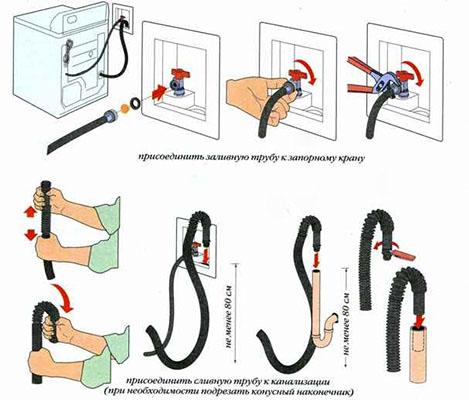
There are two main ways to connect a washing machine to a sewer:
- Through a special siphon;
- Directly by securing the drain hose with a plastic hook.
Draining into the bathtub and sink - disadvantages
The latter method is practiced quite often, since plastic hooks always come with a washing machine. Throwing a hook with a hose over the edge of the bathtub or sink, we will ensure the unhindered discharge of dirty water into the sewer.In this case, we do not need to install siphons, fiddle with pipes and connections. But not everything here is as simple as we would like.
The whole point is that direct discharge of dirty water into the sewer contaminates bathtubs and sinks. After cleaning our bathtub to a shine, we immediately pour dirty water into it with washing powder and the remnants of pollutants. And it’s good if this dirty water immediately goes into the drain - in many cases, the drain hose only reaches the other end of the tub. Therefore, dirty water will gently flow along the bottom, polluting the snow-white enamel or acrylic (depending on what kind of bath).
Another disadvantage
Consider the second drawback of such a connection - the drain hose is easily knocked off the edges of bathtubs and sinks. Therefore, the threat of flooding will constantly hang over our neighbors. Your floors will also suffer if the machine starts to drain dirty water at this time. The hoses fly off not only due to the carelessness of users, but also on their own, for example, during the spin cycle - vibrations affect. It is also not uncommon for hoses to fall as a result of turning on the drain pump - water running under high pressure through a ribbed hose makes it twitch.
If the water is drained into the bath, then this is not so bad. And if it’s in the sink, it’s a real nightmare - after all, it’s customary to wash over the sink.Seeing the streams of dirty water, sometimes with a strong aroma of dirt, is not so pleasant. Therefore, it is best to connect the drain of the washing machine to the sewer through a siphon.
Connection through a siphon is devoid of the above disadvantages - the connection is tight, there are no unpleasant odors, the probability of water leakage is extremely small. Another thing is that with such a connection you will have to tinker a little. Let's look at both connection methods in more detail.
Connecting the washing machine to the sewer through the siphon
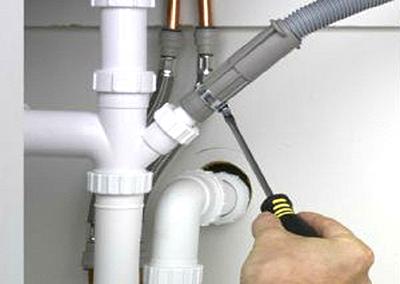
In order to connect the drain of the washing machine to the sewer, we need a special siphon, which can be purchased at any plumbing store. The siphon is installed under the sink, as high as possible to prevent the backflow of water. During the connection process, we may find that the length of the drain hose is too short. Therefore, in many cases it has to be extended. You can specify the maximum hose length in the instructions for the selected washing machine.
Plastic siphons for washing machines are endowed with pipes to which the drain hoses themselves are connected. We fix the junction of the branch pipe and the hose with a special coupling. This will help seal the connection and prevent unpleasant odors from entering the sewer.
Advantages of the connection method
Such a connection scheme is quite common, as it provides an excellent connection between the drain hose and the sewer. In this case, we can not be afraid of leaks - the siphon is equipped with a rubber cuff, which makes the junction more airtight. As for dirty water, it will be able to freely pour into the sewer.
This scheme is also good because we can safely use the sink or bathroom. Agree, when the machine is washing, you won’t take a bath - it will flood with dirty water. It is also unpleasant to wash oneself, seeing in front of oneself seething streams of foam and the same dirty water with an unpleasant odor. The maximum that can disturb us in the presence of a siphon is a soft gurgling coming from the neck of the sink.
Siphon installation
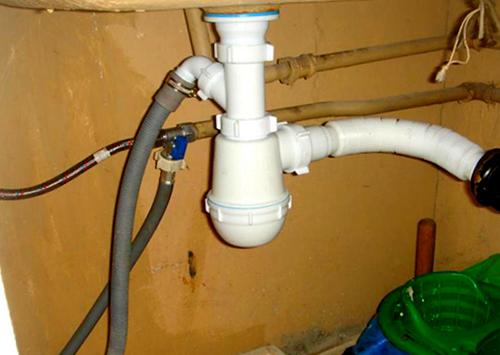
The siphon for the washing machine is always installed in a vertical position, but not in a horizontal position - such a scheme is erroneous, since leaks are possible. You also need to remember about the correct position of the drain hose. It must first rise to a height of at least 60 cm, and then descend to the drain. Usually it is hooked to the upper part of the body, where appropriate fasteners are provided.
In order to connect the washing machine to the siphon under the sink, the old siphon must be removed and a new siphon installed in its place, with a pipe for connecting the drain hose. All connections are carefully tightened to ensure proper drain tightness.. After that, open the tap with water and check our assembly.
The next step is to connect the drain hose. If there is a special cuff, then it's good. If it is not there, we use a special adapter to connect the hose, tightening it with a metal clamp to ensure tightness.
Of considerable interest are special siphons for hidden installation in the wall.On one side they are connected to the sewer pipes, and the other side looks out - here we connect the drain hoses, tightening the connection with a clamp. Usually, a cold water outlet is installed nearby so that connecting the washing machine is convenient and quick - even if you buy a new machine, it will take 5-10 minutes to install it.
We connect the machine to the sewer without a siphon
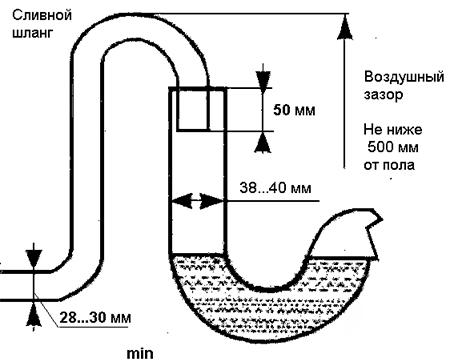
You can connect the washing machine to the sewer without a siphon. In this case, the drain hose is connected directly to the sewer pipe. To do this, a tee is placed in it, with which the hose itself is connected. In some cases, a separate plastic pipe is laid to the machine, connected to the sewer.
Connecting
The process of such a connection is quite simple - just lower the drain hose into the sewer pipe, fix it and seal the junction. If you do not seal, you will have to enjoy all the smells penetrating from the sewer. By the way, during the connection process, you need to organize an S-shaped bend in the drain hose - thereby we isolate the machine from the sewer system at those moments when the drain pump is turned off.
By the way, if the drain hose is made straight, without rises, all the sewer stink can get into the tank, where the clean and washed clothes are located. Therefore, special attention must be paid to the bending of the hose. And it is best to try to install a siphon that will cut off all unpleasant odors. To prevent sewer water from entering through the drain hose back into the drum during washing, an anti-siphon is used - check valve for washing machine.
Draining the sink and tub
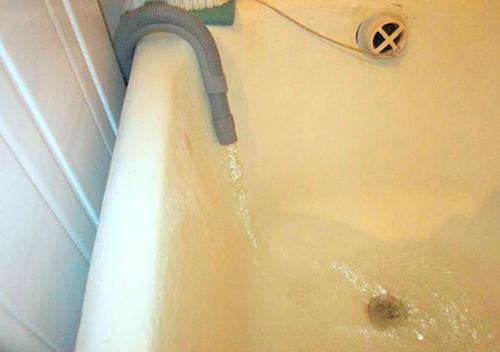
Another way to dump dirty water is to attach a drain hose to the edge of a tub, toilet, or sink. But in this case, we may face the danger of flooding our own bathroom. In order to protect your bathroom from flooding, you need to fix the drain hose well in such a position that it cannot be accidentally dropped.
Do not rest the drain hose on unstable surfaces as it may accidentally fall. It is also not recommended to fix it tightly - then it will be subject to falls from vibrations. Remember, if it is not possible to fix the drain hose in a free and safe position, then it is best to connect the washing machine to the sewer through a siphon - it is not very expensive, but it will help protect the bathroom from accidental flooding.
In addition, a siphon with a pipe is a reliable protection against unpleasant odors. But if you still decide to connect directly to the sewer, do not forget to give the drain hose an S-shape to isolate the washing machine from sewer odors.
Conclusion
In conclusion, we can conclude that the safest way to connect a washing machine to a sewer is to connect through a siphon.
